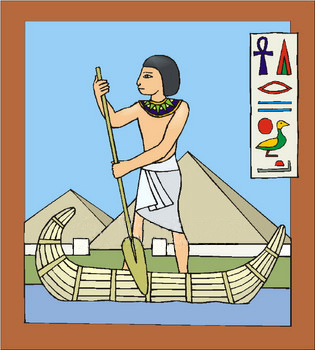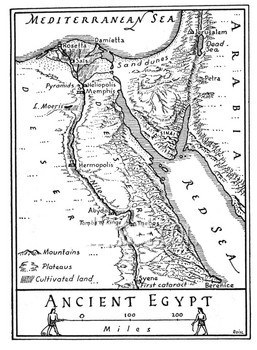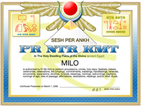Summary: Hapi is the Kemetic (ancient Egyptian) God/Goddess of the Nile.
names:
Kemetic names: Hapi, Hapy, Hap, Hep
Greek name: Neilos (from Kemetic, or ancient Egyptian, “nwy”, meaning water or river)
Latin name: Nilus
English name: the Nile
(NOTE: In addition to native variations by locality or over time, there are often several possible transliterations into the Roman alphabet used for English.)
basic information:
Hapi — Goddess/Deity of the Nile: Hapi was the Kemetic (ancient Egyptian) deity of the Nile (the ancient Egyptian name for the Nile was Hapi, see hieroglyphs below). Hapi was both fully male God and fully female Goddess, with full breasts, vagina, penis, and testicles. Created by the merger of Nun (Goddess of water) and Min (God of fertility).
Hapi was sometimes depicted as a mother hippopatamus or with the head of a mother hippo. Hapi was typically shown with two giant water jars spilling out with streams joining. The water jars (long thin cylinders that bowed in the upper half) represented the White Nile and the Blue Nile. The modern astrological figure of Aquarius came from this ancient Egyptian deity. In modern times, many transvestites and other transgenders honor Hapi.
 |
 |
| Nile Delta | Nile River |
| hieroglyphs courtesy of Jim Loy | |
Hapi’s relations:
Hapi: Created by the merger of Nun (Goddess of water) and Min (God of fertility).
holy days
Day of Welcoming: July 25. Kemetic (ancient Egyptian) holy day. The ancient Egyptians welcomed the annual rising of the Nile River and made offerings to the neteru.
other:
 Ancient Egypt (Kemet) was also dominated by the Nile River. The Nile River flows north. Either the largest or second largest river in the world (the other contender being the Amazon River) at 6,677 km (or 4,180 miles [note those numbers do not convert exactly]), the Nile also had unique characteristics that helped the nation of Egypt grow into a great civilization. Ancient civilizations first grew up on major river systems. One kind flooded, providing rich nutrient top soil renewal. The other kind provided a steady flow of water year round. The Nile has two sources, one of each kind, making it the only large river system in the world with both characteristics.
Ancient Egypt (Kemet) was also dominated by the Nile River. The Nile River flows north. Either the largest or second largest river in the world (the other contender being the Amazon River) at 6,677 km (or 4,180 miles [note those numbers do not convert exactly]), the Nile also had unique characteristics that helped the nation of Egypt grow into a great civilization. Ancient civilizations first grew up on major river systems. One kind flooded, providing rich nutrient top soil renewal. The other kind provided a steady flow of water year round. The Nile has two sources, one of each kind, making it the only large river system in the world with both characteristics.

The Nile River provided a continuous waterway that was straight and navigable for more than 2,500 miles. For about ten months out of the year, the prevailing winds blew in the exact opposite direction as the flow of the current, providing low cost water transport in both directions. The Nile River flows north into the Mediterranean Sea, with the predominant winds blowing to the south.
The two sources of the Nile, the Blue Nile (source in the Abyssinian Mountains) and the White Nile (source in the Victoria Nyanza), join at Khartoum (in modern day Sudan), forming the Nile proper. In modern times the Nile divides a few miles north of Cairo into the Rosetta and the Damietta branches.
The Nile proper is about 1,800 miles long and has been used for irrigation at least since 4,000 B.C.E. The Blue Nile is approximately 1,609 km (about 1,000 miles) flowing from northwest Ethiopia to the Sudan and is the primary headstream of the Nile. The White Nile flows mostly northward through eastern Africa.

The cyclic nature of the annual flood of the Nile River had a profound effect on the Kemetic (ancient Egyptian) religion.


“The Nile River valley in Egypt was the site of the world’s first great civilization.” —Princeton University
Greek historian Herodotus called ancient Egypt “the gift of the Nile”.
The ancient Egyptians knew that their lives depended on the Nile. It was a national disaster if the Nile over-flooded or under-flooded. They constructed artificial banks to prevent over-flooding and constructed irrigation channels to carry the water to the fields.
The fertile black soil of the Nile (the Black Land) was contrasted with the barren red soil of the desert (the Red Land). The ancient Egyptians viewed black as the color symbolizing good and red as the color symbolizing evil.
religious title certificate

Get a beautiful certificate declaring that you are a priestess, priest, high priestess, high priest, hem, hemet, kher, sesh per ankh, scribe, witch, or shaman of Hapi. This is a real religious certificate meeting government standards for conducting marriages and other ceremonies.













